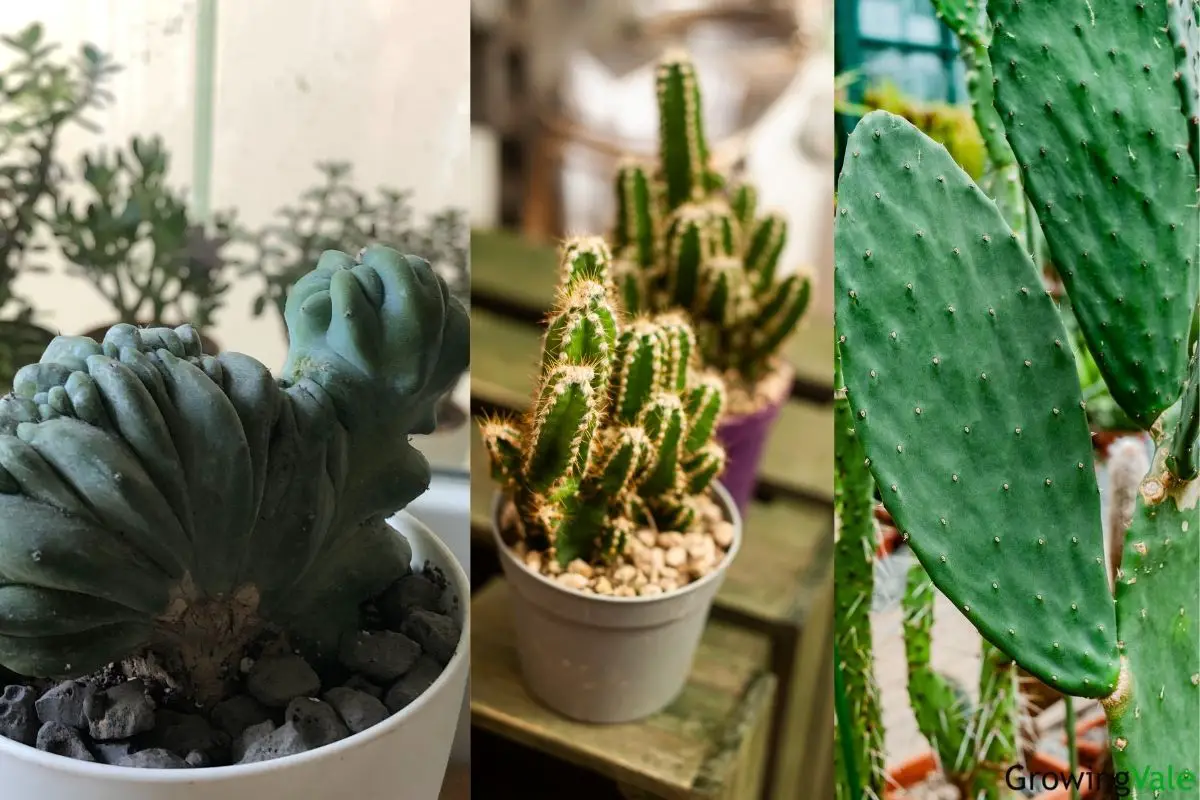Most varieties in the cacti family that are readily available to home gardeners and enthusiasts are fairly easy to grow and pretty hard to kill. These plants require very little maintenance and many are drought tolerant and require minimal watering.
The main problem that people have with growing cacti is overwatering. This is because cacti originate from desert regions and are adapted to growing in areas that receive very little rainfall. Their stems are designed to store water so that the plant can easily survive long periods of dry weather.
This means that giving these plants too much water, especially when grown in containers, causes the roots to rot and the plants to die. In fact, you should let the soil dry out completely before you give your plant any more water. Many species can survive for a number of weeks without additional water especially in the colder months.
Therefore, when growing any species of cactus at home, be sure not to overwater it and it will happily grow and thrive.
Here are different types of cactus that you can easily grow at home.
Christmas Cactus
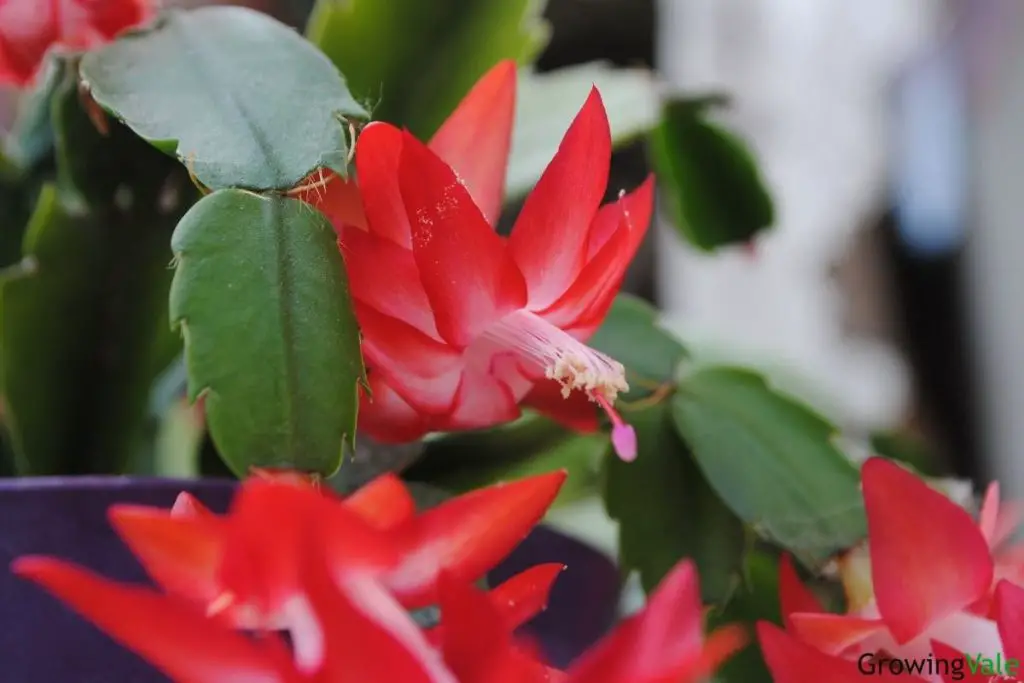
Christmas cactus (Schlumbergera bridgesii) produces red, pink and while flowers.
If you’re looking for beautiful flowering cactus plant types to grow indoors, these cacti will provide incredible blooms.
Also known as Thanksgiving cactus, Easter cactus and holiday cactus, these types of cacti are best grown in a small container and you don’t need to repot them often.
Beavertail (Opuntia basilaris)
This is one of the prickly pear cacti that have fleshy blue-green pads covered with a multitude of white or brown areoles with prickly glochids. Compared to other prickly pear cacti, this variety is smaller growing and only reaches a height of around 2 feet. It does form clumps that can reach a diameter of 6 feet.
The beavertail cactus produces dark cherry small pink flowers in late winter and early summer. These are fragrant with a fruity scent. This plant likes to grow in full sun in a well-drained sandy loam.
Blue Columnar (Pilosocereus pachycladus)
This is quite a spectacular cactus that produces a tall and erect light blue stem. This stem is deeply ribbed with masses of golden brown areoles along the edges of the ribs. These have multiples of short, prickly spines.
If grown outside, this plant can reach a height of 30 feet although it’s quite slow-growing. It produces white flowers in summer. They can have either green or red outer segments and are funnel-shaped. Generally, the flowers first open at night and continue into the day. Flowers will only start to appear when the plant reaches at least 3 to 4 feet in height.
Blue Flame (Myrtillocactus geometrizans)
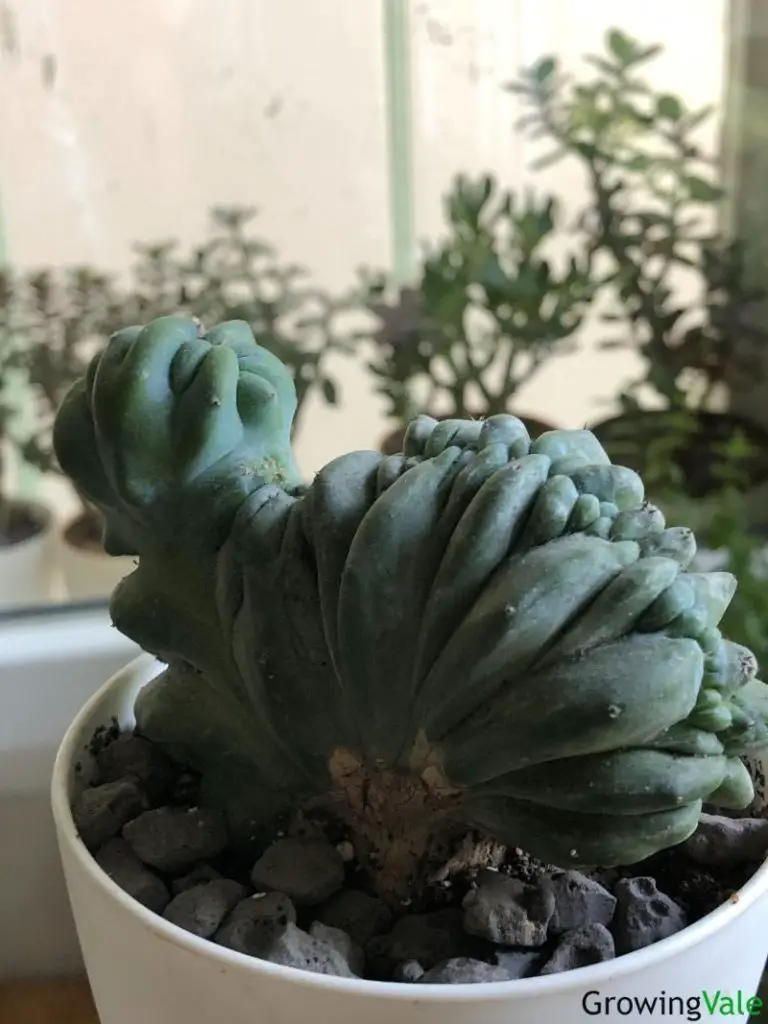
The blue flame cactus is a candelabra-shaped cactus with flowers much like the ones you see in cartoons. In its natural habitat, it can grow up to 15 feet tall. The stems are blue-gray and have about 5 to 8 distinct ribs. The stems are covered with widely-spaced areoles that have around 3 to 5 short spines.
The flowers on this cactus are quite small and greenish-white. After flowering, the plant produces small, sweet edible fruit. The fruits are dark red and oblong. Grow this cactus in full sun or on a bright windowsill in a well-drained cactus mix that has added gravel for drainage.
Bunny Ears (Opuntia microdasys)

The popular bunny ear cactus has fleshy green pads that grow on top of each other and look just like bunny ears. The pads are covered with lots of tiny areoles that have bristly glochids or hairs that are very prickly.
This is a low-growing cactus that is perfect for growing in pots. There are a number of different varieties. Some have white glochids while others have bright red ones. This plant is extremely easy to grow and propagates readily by removing one of the pads and putting it into some cactus mix.
This variety rarely flowers in cultivation but when it does, the flowers are generally pale yellow and sometimes tinged with red.
Candelabra (Myrtillocactus cochal)
As the name suggests, this is another candelabra-shaped cactus that is easy to grow. It produces a multitude of candelabra-like branches from a short woody trunk. The areoles on the ridges of the stems are around 1 inch apart and have short gray or black spines.
Flowers appear in summer at the tip of each stem. They are usually cream in color and sometimes tinged with purple. After flowering, the plant produces edible fruits that are red and tinged with yellow or brown. These fruits are juicy and slightly acidic.
This cactus variety likes to grow in full sun in a fast-draining succulent mix.
Claret Cup (Echinocereus triglochidiatus)
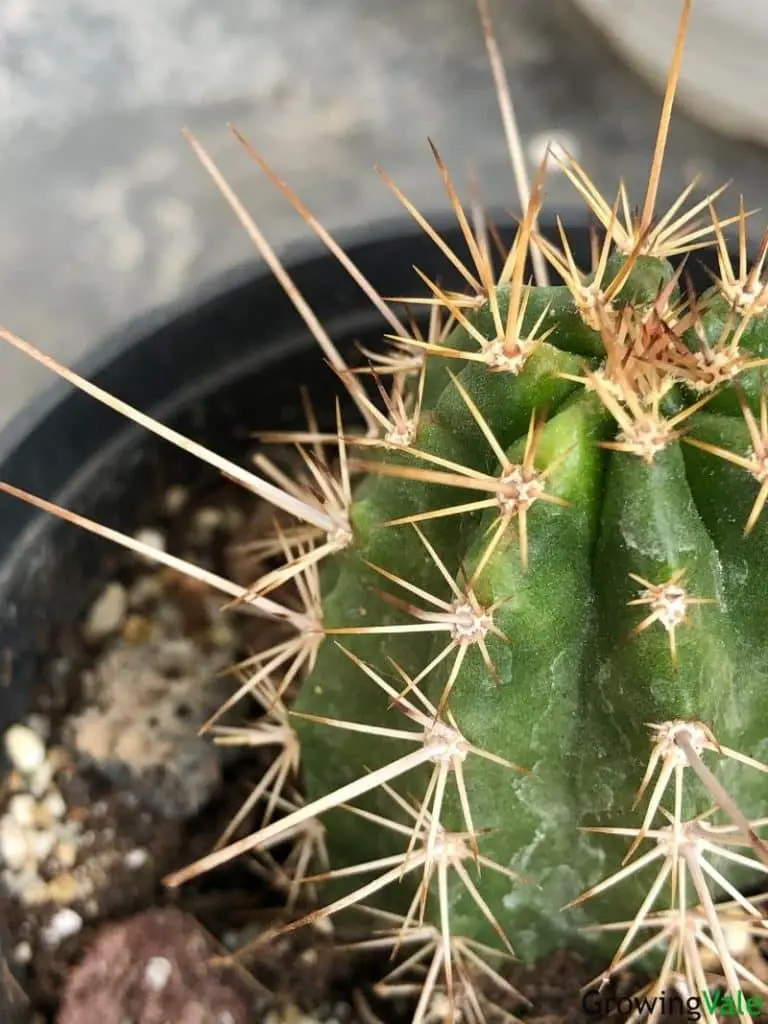
The claret cup cactus is one of those types of blooming cactus with striking blossoms. They are bright orange-red in color and have many petals that are formed into a cup shape. This plant produces thick rounded or cylindrical stems with ribs. These stems are covered with yellow, pink, or black spines that grow out of wooly areoles.
The fruits of this cactus are edible, sweet, and juicy. They are a greeny-yellow or pink in color and taste like strawberries. This plant prefers to be grown in a sunny spot in a succulent mix that has additional gravel added.
Fairy Castle (Acanthocereus tetragonus)
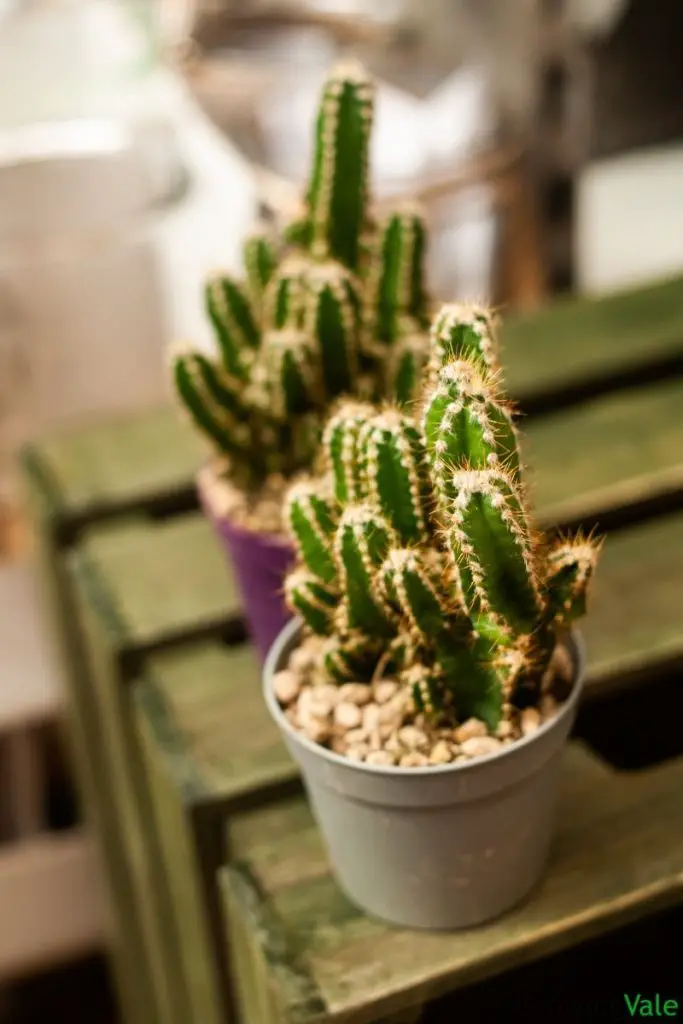
The fairy castle cactus is quite a whimsical cactus that produces cylindrical stems that grow very close together and are varying heights. These unusual cacti resemble a castle with their spires and turrets. To add to the fairy-tale look, the stems have wooly white areoles that have short creamy-white bristly spines.
It’s a slow-growing cactus but if planted outside, it can eventually reach a height of 6 feet. This plant rarely flowers in cultivation but is more grown for its unusual shape.
Feather Cactus (Mammillaria plumosa)
This delightful little cactus is covered with a mass of fine feathery-looking spines that are quite soft. The plant produces low, dense mounds in clumps. These mounds are completely covered with the long hairy spines. Underneath these hairy spines, the cactus mounds are light green in color.
The flowers are almost daisy-like and are whitish-yellow with a dark green center. They have a very strong, sweet scent. This is definitely an interesting-looking cactus to add to your collection.
Golden Ball (Parodia leninghausii)
The golden ball cactus starts out as a globular shape but the stems become more columnar as the plant grows. The stems grow into clusters and are covered with masses of golden yellow spines. These spines are bristly and not sharp.
This cactus will only bloom once it’s reached the age of around 5 years. The flowers appear in spring and summer and are pure yellow in color. They are quite silky and have a lovely shine almost resembling paper daisies.
Unlike a lot of other cactus varieties, this plant can be grown in full sun to partial shade. It prefers a fast-draining cactus mix.
Golden Barrel (Echinocactus grusonii)

This is a visually striking cactus with its round barrel-like shape and covering of yellow spines. If grown outdoors, this makes a great landscaping plant in desert gardens and rockeries. It can reach a height of 4 feet.
The golden barrel is also ideal for planting in pots either outdoors or inside as long as it gets plenty of light. The flowers are a vivid yellow color and form on the crown of the plant.
Grow this barrel cactus species in full sun in an open and well-drained succulent mix.
Lady Finger (Mammillaria elongata)
This ladyfinger cactus is a lovely low-growing plant that’s ideal for growing in a pot or adding to a container-grown cactus garden. It only grows to about 6 inches in height. It forms tight clumps with mostly erect stems but these can grow sideways too.
The areoles and spines form a spiral around the stem, giving this cactus a distinctive appearance. The spines are usually yellow or brown. The plant produces small bell-shaped flowers that can be white, pale yellow, or pink. It mainly flowers in spring but can put on another display later in the year.
Mexican Fence Post (Pachycereus marginatus)
This is an imposing cactus variety that forms a tall single columnar stem. Each stem can grow to a height of 16 feet. This cactus would make a great specimen to add to an outdoor rock garden but is also ideal for growing in a large pot.
The stem of this cactus has very distinct ribs that have sharp spines along the length. The flowers are pink to green and there can be up to 2 flowers sprouting from each areole. These appear in spring. An interesting fact about this cactus is that it is commonly used for fencing in Mexico.
This plant should be grown in full sun in well-drained soil. Use a commercially available cactus mix if growing in a pot.
Moon Cactus (Gymnocalycium mihanovichii)
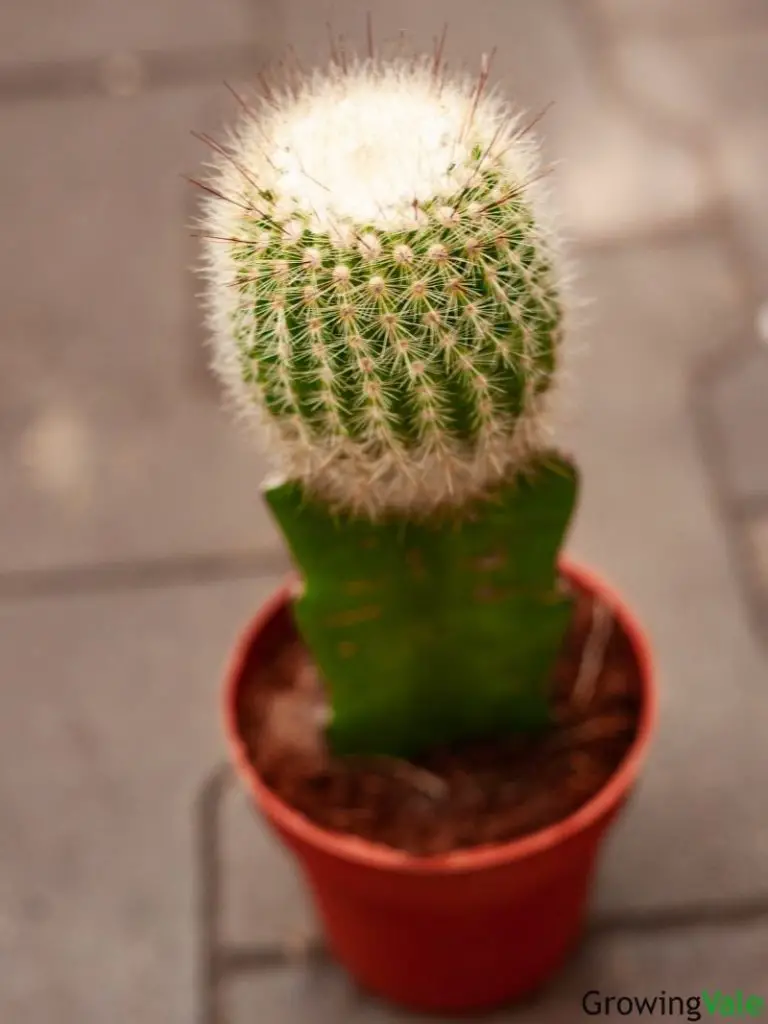
Moon cactus is one of a few interesting hybrid indoor cactus plants that are popular among collectors. The plant is a mutant that does not have the ability to produce its own chlorophyll. Therefore, it needs to be grafted onto another cactus that serves as the rootstock.
There are over 80 species of moon cactus in vibrant colors of orange, yellow, and hot pink. These plants are ideal to grow indoors on a bright windowsill. However, they don’t live for very long. These cacti are commonly referred to as Hibotan plants and belong to the Gymnocalycium genus.
Old Lady (Mammillaria hahniana)
This is a ball-shaped cactus plant that is covered with long, thin, white flexible hairs. These hairs are so profuse that they hide the cactus stem almost totally. This is a great cactus for beginners because it tends to flower profusely, even at a young age.
The flowers are bright pink and are produced on the crown of the plant in a ring. The plant’s blooming season is from late winter to spring. After flowering, the plant produces red, club-shaped fruit.
Old Man (Cephalocereus senilis)
This cactus has the most interesting feature when it’s young. It grows as an erect columnar specimen that is covered with a shaggy coat of white silky hairs. However, as the plant ages, it does lose this wooly covering to reveal the sharp yellow spines beneath.
If grown outdoors, this cactus can grow up to 49 feet tall. It will produce side stems that grow night-blooming flowers in spring. These flowers are funnel-shaped and rose or yellowish pink in color. The plant prefers to be grown in full sun in a commercial cactus mix that is well-draining.
Orchid Cactus (Epiphyllum crenatum)
The orchid cactus is very popular and widely grown by cactus and succulent lovers. The stems are leaf-like and notched. The plant produces multiple stems that are erect at first and then tend to cascade downward. These make this plant ideal for growing in hanging baskets.
Flowers are produced on the tips of the stems and are strongly fragrant. The flowers are striking and quite large, reaching a diameter of 4 inches. Flower colors vary from pinks and reds to whites, yellows, and orange.
Orchid cactus likes to be grown in filtered sunlight. It can be grown in a standard potting mix that has some extra sand and coconut fiber added to assist in the drainage.
Organ Pipe (Lemaireocereus thurberi)
This is a columnar cactus that produces multiple stems from the base. These stems resemble organ pipes and are well ribbed. The areoles are brown felted and have numerous sharp spines.
The flowers on this cactus are white to pale lavender and have a funnel form. After flowering, this cactus produces large fruits that are edible and quite delicious. Grow organ pipe cactus in full sun in well-drained gritty soil. Use a cactus mix if growing in a pot.
Peanut Cactus (Echinopsis chamaecereus)
This is a low-growing cactus that produces numerous finger-like stems. It can reach a height of around 1 foot. This cactus flowers profusely in spring and early summer. The flowers are large, vase-shaped, and usually bright red in color.
Each stem is ribbed and has short soft spines along the edges of the ribs. The plant produces multiple offsets that can break off and be used for propagating new plants. Over the years, many hybrids have been developed with a variety of different flowering colors.
Grow peanut cactus in full sun but provide some afternoon shade in areas that experience extreme heat in summer. Use a fast-draining succulent mix with some added grit.
Prickly Pear (Opuntia ficus Indica)
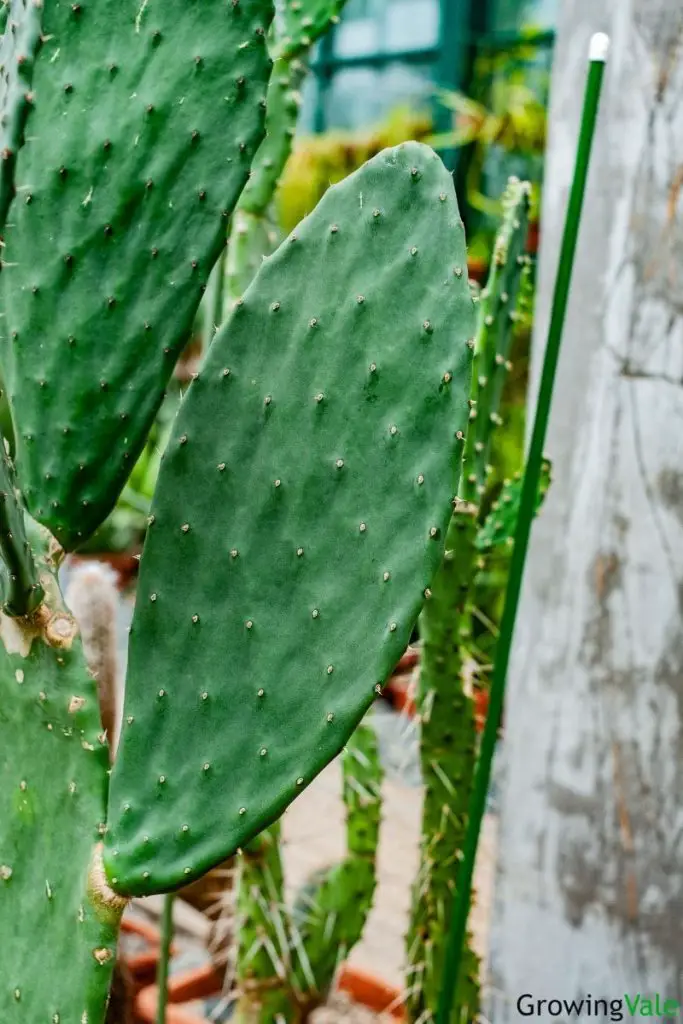
The prickly pear is one of the most well-known cactus varieties around the world. It produces large paddle-shaped pads called cladodes. In its native country of Mexico, these pads are cooked and eaten.
As one of the most common tall cactus types, if grown outdoors, this cactus can easily reach a height of 15 feet and it’s also a prolific spreader.
In fact, one plant can spread to be around 6 feet wide. This cactus also propagates readily and needs to be kept under control if grown outdoors. It has become a pest in some parts of the world.
However, it’s a great specimen for cactus collectors because it’s so easy to grow. This large cactus produces large flowers that can be either bright yellow or orange-yellow. After flowering, the plant produces red to purple fruits that are juicy and edible.
You can grow prickly pear cactus in full sun or partial shade. It prefers a well-drained sandy soil or a cactus mix with plenty of gravel added.
Rat Tail (Disocactus flagelliformis)
This is a popular creeping cactus that has been grown in cultivation for nearly 300 years. It produces long, slender stems that are branched making this plant ideal for growing in hanging pots or baskets.
Each stem has a mass of tiny, bristle-like spines that are often red in color. This plant also flowers profusely. It produces large tubular blooms that can be red or a dark pink color. The plant also produces globose fruit that is red with a yellow pulp.
It prefers to be grown in full sun and you can use a standard potting mix as long as it is free-draining.
Saguaro (Carnegiea gigantea)
The saguaro cactus trees are one of the most famous cactus species due to its large size and interesting architectural shape. It is often used in landscape plantings to add interest and makes an imposing statement.
This is a large, tree-like cactus with tall, columnar stems that branch out from a short trunk. The stems are ribbed with rigid gray or black spines. Interestingly, while the plant is still in its immature stage, it produces just the one columnar stem and this does not flower.
It’s not until the plant matures and starts growing its branching stems that the flowers start to appear. The flowers are white and quite showy. The fruits that follow are egg-shaped with spineless scales. The juicy pulp is bright red and edible.
The saguaro cactus should be grown in full sun in a gritty cactus mix that is fast-draining.
Silver Torch (Cleistocactus strausii)
The silver torch cactus can make a striking addition to any cacti collection. It has thick columnar stems that are completely covered with silvery, white bristles. Each columnar stem can grow up to 8 feet tall.
The flowers are 3 inches long and tubular. Interestingly, these grow horizontally from the sides of each stem. They are normally a deep rose color. This plant can handle full sun to partial shade. It needs an open sandy mix.
Star Cactus (Astrophytum ornatum)
The star cactus is the fastest growing of the Astrophytum species. It’s also the easiest to grow. The plant produces singular columns that are quite wide and look star-shaped from above. These stems have white cross bands of wooly scales giving each stem a striped appearance.
The columnar stems also have wide, deep ribs that have long, sharp spines coming out of wooly areoles on the edges. This cactus also produces large lemon-yellow flowers that have orange centers. Grow in full to partial sun and use a sandy mix that is fast-draining.
Strawberry Hedgehog (Echinocereus engelmanii)
This is another low-growing cactus that only reaches a height of around 28 inches. It produces multiple branches from the base that are mostly erect but can sometimes be prostrated. Each stem is covered with long, sharp spines that can vary in color.
The plant produces bright pink flowers in spring that are diurnal. This means they close at night and open again in the morning. The fruit on this cactus is red or orange and also covered in spines. It is edible and tastes like strawberries. This Echinocereus cactus plant can be grown in full sun in a standard cactus mix.
Teddy Bear Cholla (Cylindropuntia bigelovii)
This type of cholla cacti has to be the cutest cactus in our selection. It’s a shrub or small tree that has a distinct trunk with many horizontal fleshy branches. These branches are covered with dense spines that are golden in color and appear furry. When the sun hits this plant, the spines actually glow.
It’s important to note that the spines are rather sharp and have a hooked end so take care not to touch them with bare hands. The yellow-green flowers appear at the tips of the stems in spring and occasionally in the fall.
These cute cacti also produce cylindrical fruits that are yellow in color. Quite often the branches will fall off and these can be used to propagate new plants. It likes to grow in full sun and you must let the soil dry out before watering.
Totem Pole (Pachycereus schottii f. monstrosus)
This bizarre-looking cactus belongs in everyone’s collection purely for its interesting-looking shape. This variety originated by first producing an abnormal growth form. This happens occasionally with different cacti species and these unusual forms are referred to as “monstrous forms”.
The most interesting thing about this columnar cactus is its knobby shape. When young the plant looks like a fleshy, green totem pole. It does have some ribs but these are almost hidden by the knobbly growth. The plant generally has no spines and rarely flowers. However, it is an interesting specimen to add to a potted cacti garden or to an outdoor rock garden.
Turk’s Cap (Melocactus matanzanus)
This is one of the most commonly grown varieties by cactus lovers. It’s one of the common small cactus plants but with an interesting appearance. The plant grows a spherical stem that is pale green and ribbed. Protruding from the edges of the ribs are closely-spaced groups of short, sharp spines.
The most interesting thing about this cactus is the cephalium that develops on the crown of the plant as it matures. The cephalium is a round cap-like structure and it’s where the flowers will eventually form. This cephalium is tightly packed with wooly areoles that bear dense orange bristles.
The flowers are generally small and rose pink, however, they do not emerge fully. It actually takes around 4 to 5 years of growth before this cactus will start flowering. Eventually, clavate berry-like fruit will appear that are lilac-pink.
Conclusion
Many of these indoor cacti are perfect to keep in your home, especially your living room. Other cactus types can be grown outdoors. Remember, cacti are succulents but not all succulents are cacti.
Check our blog for more types of succulents you can grow and our guide on cactus care.

